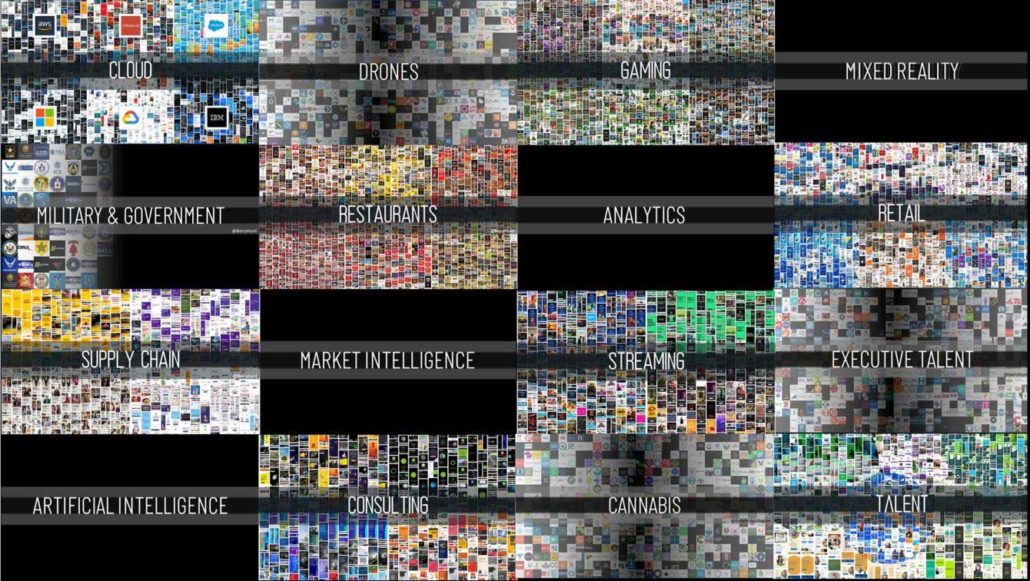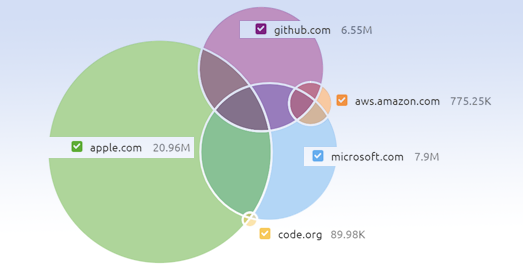A sneak peak of my work….
As part of providing ongoing market research and digital strategy I publish several news streams that are simple methods of interacting with a tremendous amount of information.
On any given day the backend process to create this news stream helps identify thousands of curated resources. The example data trends includes topics such as #Innovation, #Startups, #AI, #MR, #Privacy, #SmartData, #Analytics, #Cloud, #Drones, #CyberSecurity, #CompetitiveIntel, #OSINT.
Behind the scenes it gets fairly complex covering dozens of industries and visualizing that data requires significant filtering. Outside of the core ‘Microsoft’ example I will go over, the image below shows a sample industry breakdown.

Insight requires Focus.
Experience helps tune through all the digital noise and the massive volume of information. To help clarify the process I will narrow down to one of the larger companies that tends to interact with these topics: Microsoft.
Why Microsoft?
Words are very powerful things.
In the data driven world words represent all sorts of things such as brands, people, places, and experiences. They identify trends, like-minded ideas, and the abstract thoughts powering digital transformation in every industry.
Understanding how words = data and data = everything is critical to establishing how a word like ‘Microsoft’ can have gravity and create a universe of information around it.
That universe of information becomes priceless when it is converted into meaningful things like business intelligence, talent acquisition, product development, market research, customer acquisition, and industry innovation.
Data comes from EVERYWHERE
These insights rely on mapping data across dozens of unique partners to segment meaningful relationships and impacts. Keep in mind that these numbers change daily.
As an example of the data volume available: a single data partner discovers over 40 million new pages every 24 hours and they provide over 5 billion reference sources that each pivot into approximately 500 different data points.
(I.E. 2,500,000,000,000+ points of data.)
That same partner provides a straight-forward breakdown of localized information requiring an immense infrastructure including 135 databases in 118 countries and 16 languages. It also includes 427,000,000 domains, 120,000,000 keywords, and 40,445,000,000,000 web links.
What does some of that Microsoft data look like?
Content
There are approximately 100 different Microsoft related segments broken up by primary industries and top market contenders. Examples include Azure, Hololens, and Power BI. Microsoft as a stand-along topic involves over 35 million URLs that originate from roughly 3.6 million unique domains. These 3.6 million domains represent everything from journalists, strategic partners, and industry channels.
Social Influencers
There are “a few” thousand folks who create Microsoft related content. Some of the official Microsoft related accounts represent content published to about 250 million audience members across the same 100+ business segments. Advocate channels represent approximately 500 additional employees that focus on varying areas of industry expertise (and represent dozens of segments with audiences in the 10k to 50M range.)
Keywords
The cluster of top 250 keywords associated most directly with Microsoft include a core search volume of about one million in the United States. Those 250 keywords connect to another 1.8M phrases that include the word ‘Microsoft’ and 105M keywords that are semantically related. On any given day there are 50,000 searches for people querying one of 245k different Microsoft questions.
Market Segments
For every keyword, hashtag, industry topic, technology segment, social network, or talent pool there models for isolating and extracting key items of interests. An example industry segment of audiences exploring technology education could be between Microsoft, Apple, and AWS touching content and community structures created by Github and Code.org. The high-level view of the nearly 30M keywords looks like the image below.

Technology
Microsoft is one of the most complex, if not the most complex technological ecosystem environments in the world. Only AWS has a comparable technology footprint. Both organizations interconnect hundreds of primary platform tools and consist of thousands of tiered strategic partners representing parallel technology matrixes and expert level service groups. Microsoft.com has over 31M indexed URLs, however the top 100 subdomains on Microsoft.com only represent 1.4M of those URLs.
Key Employees & Relationships
Microsoft employs over 185,000. The top ten industry partners represent 10X that number. Microsoft maintains strategic relationships with several dozen corporate partners and is connected to thousands of organizations that serve as vendors and channel partners. At an individual level, any given professional has up to 200+ data fields available through multiple data partners.
Careers and Direction
A constant state of competition across hundreds of market segments requires Microsoft to continually seek out new talent. At any given time the corporate behemoth has thousands of job openings. The top ten strategic partners who recruit around key Microsoft initiatives represents thousands more. Job requirements and team structure on seniority, geographic, and skills based levels indicate where different organizations are developing competitive foundations.
Events
Microsoft is involved with hundreds of sizable events every year. These include major events like BUILD, Inspire, E2, and Ignite- as well as smaller regional, partner, and industry segment events. For segment examples Microsoft maintains a dozen Microsoft Reactors for startups, as well as over 40 Microsoft Technology Centers around the world.
Thinking about the bigger picture.
The universe surrounding Microsoft is massive, but it doesn’t exist in a vacuum. Microsoft competes with everything from system integrators and consulting partners to equally massive competitors that connect to similar ecosystems. The simplified Cloud Layers graphic below helps demonstrate how someone might look at a quick market slice of related organizations.

Applying it to your business:
Building your Intelligence Matrix
Check out my article on the five foundational questions to start using data to drive your business forward.
+ Get engaged and reach out.
I’m available to email and can be found chatting with a lot of folks over on Linkedin.